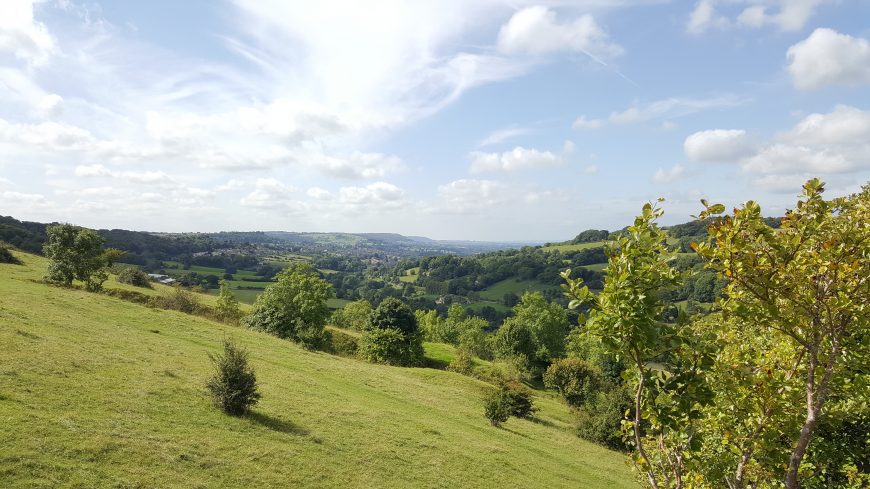Gloucestershire has many wonderful places to see orchids, but for me Swift’s Hill is a favourite. This steep hilled pasture is tucked away off a tiny lane overlooking Slad. It surprises and changes with each visit and is remarkable for having orchids flowering for pretty much the entire season. This means that a visit at almost any time from mid April to early September will be rewarded with a find – quite apart from the peace and stunning views. There are no rare or endangered species here but the full range of orchid types are on show – ‘typical’, ‘impersonators’, helleborines, and others.
The reason this for diversity seems to be the wide variety of mico-environments; damp meadow, dry slopes, woodland, chalk down. This habitat diversity does lead to combinations of species rarely seen together – especially on a site this size. Another apparent reason is due to it never having been ‘improved’ by the use of pesticides, herbicides or fertilisers. Nearby Rodborough Common allegedly has more species and its show of Chalk Fragrant Orchids is a sight to behold, likewise Ashton Court for Green Winged Orchids, but Swift’s Hill combines it in one bite sized space.
I’ve been told that 14 species of orchids have been seen on Swift’s Hill. Over the years I have found 11 of them. I know that the Frog Orchid has been seen and imagine that Musk Orchids could be here as they are found in similar conditions at two other great sites nearby – Birdlip Down and Cleeve Common. This post features the species that I have found, including some unusual variants as well as a short section of other things of interest at the end. The photos are records and not my pitch for photography prizes! But they are all from the Swift’s Hill site, taken 2012 – 17 and are arranged in roughly the order of the flowering season. The only exception to this order is the collection of other finds at the end of the blog.
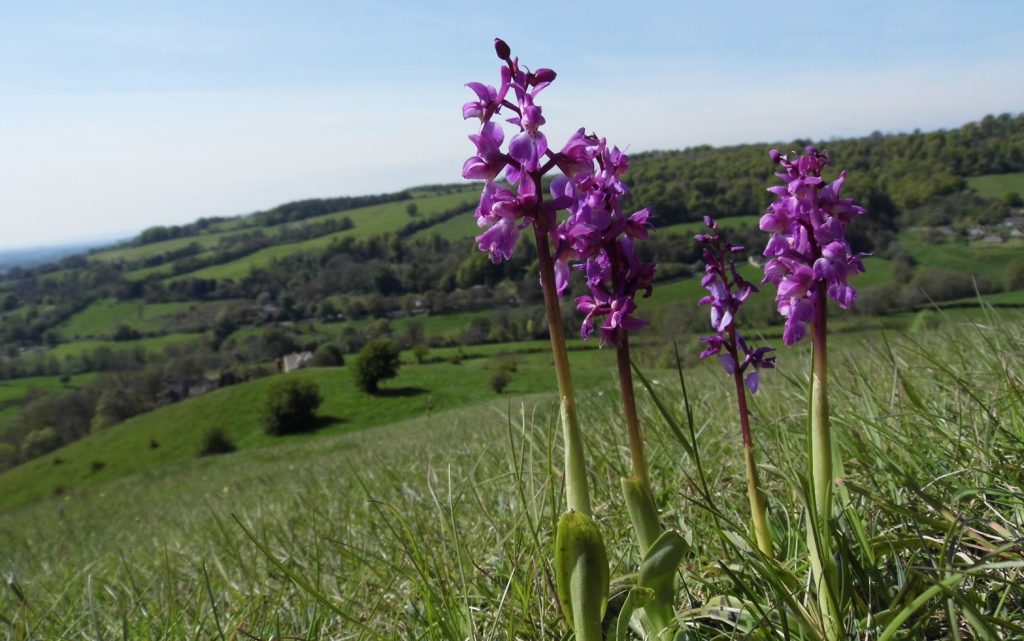
Early Purple Orchid near convergence of Bee and Frog Paths
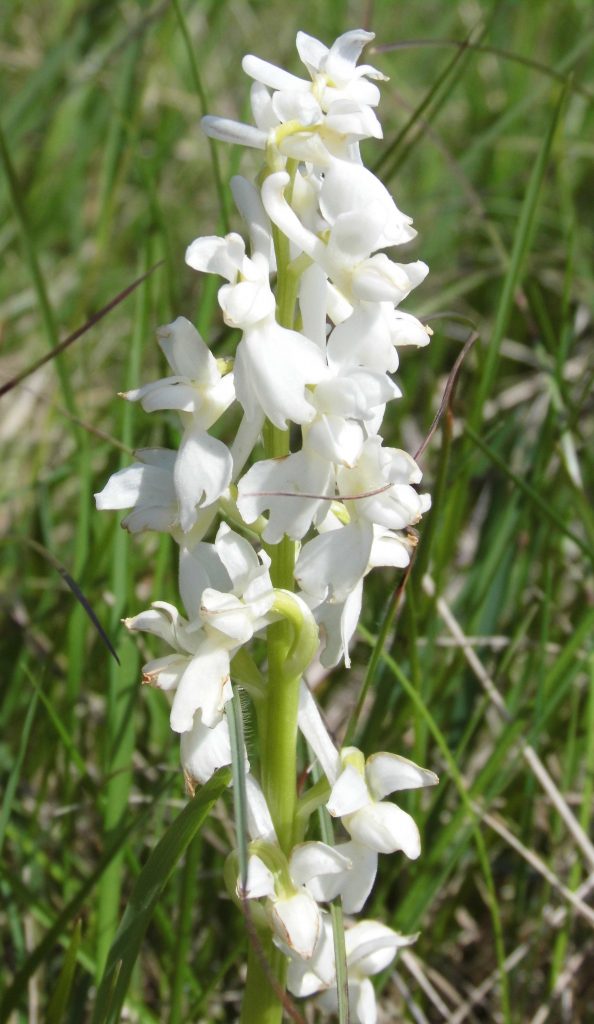
The season begins with the early purple which due to the quite dry and exposed position tend to be quite short and stocky. Occasional plants grow in the woods around the old quarry workings and these are larger. Numbers vary with thousands on a good year dwindling to a few hundred in the dry conditions of recent years. Another interesting thing to find here are a few white ‘purple’ orchids!
Like most orchids, particularly the ‘typical’ orchids (those growing with relatively small purple flowers on spikes) the mostly form a band around the mid level of the meadow, but like only two other species are found throughout the site.
The white form is quite scarce nationally and does not flower every year on this site
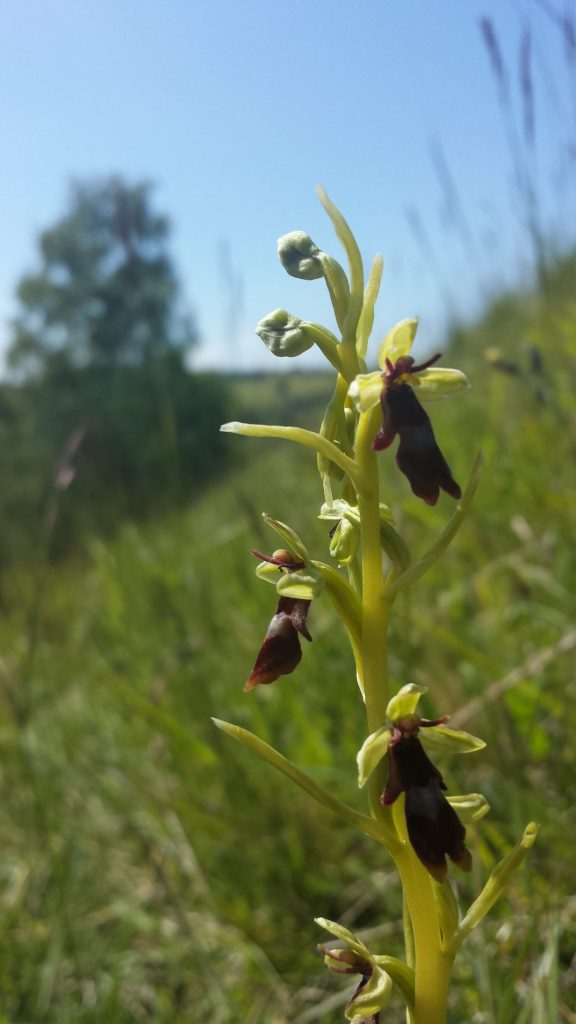
Fly Orchid below fly path looking towards Silver Birch
Two of my favourite speices growing on Swift’s Hill flower at roughly the same time. Just below the lower path, and occasionally above it a small colony of Fly Orchids flowers in early may. There are only around 20 plants here, although I have heard they grow elsewhere on the site. They grow in relatively tall grass for this site and being quite small are easy to miss. I mostly notice the yellow / green stems before the flowers. Although some have grown to almost 30cm on this site, for the past couple of years they have been no more than 20cm tall.
At the same time and almost at the other side of the site, below the lower plateau is a small colony of Green Winged Orchids. This section of the site is slightly damper and has a short yet lusher ground covering. Of all the orchids on the site this is one of the scarcest and in terms of the county I’d say most precarious. The nearby colonies of Bee Orchids, although just as small in number are part of a much larger countywide population.
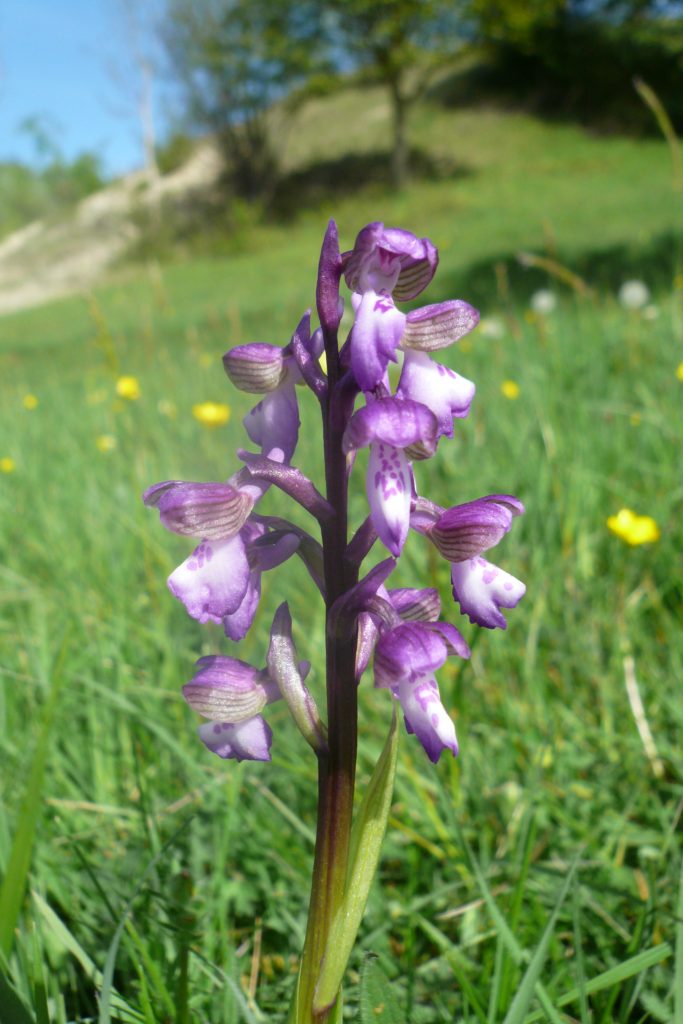
Green Winged Orchid below the lower plateau
The Green Winged Orchid colony here is less than 20 flowering spikes and can be easily missed as at first glance it seems like the far more plentiful Early Purple that is there too. However, generally, Early Purple Orchids have purple blotched leaves and the lateral sepals, the hood like top of each Green Winged Orchid flower has greenish veins. By far the best display of this beautiful species in all its stunning variety is near the golf course at Ashton Court near Bristol, where perhaps 10k flowering plants forms one the largest single species displays of any orchid site I know.
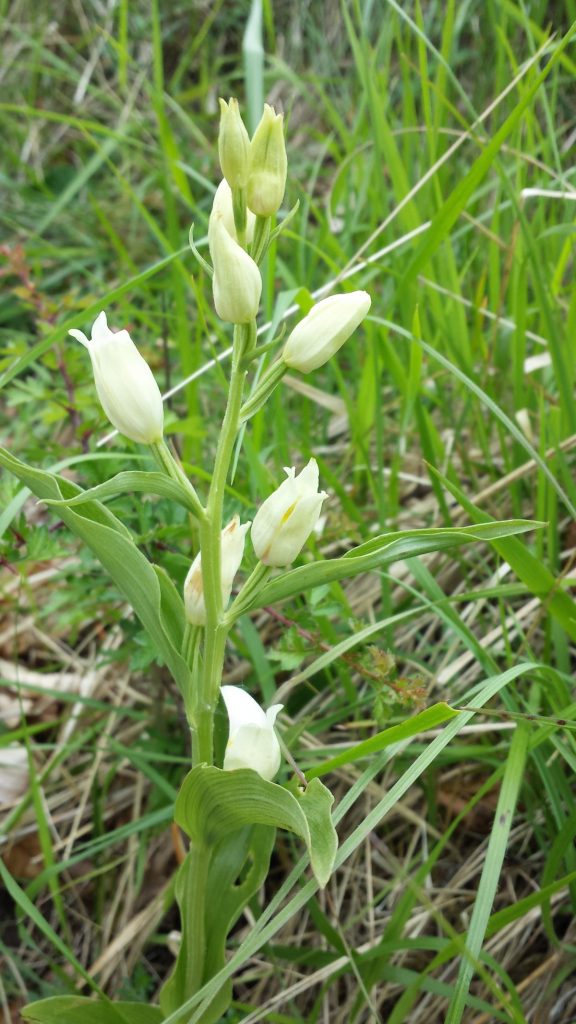
White Helleborine below fly path
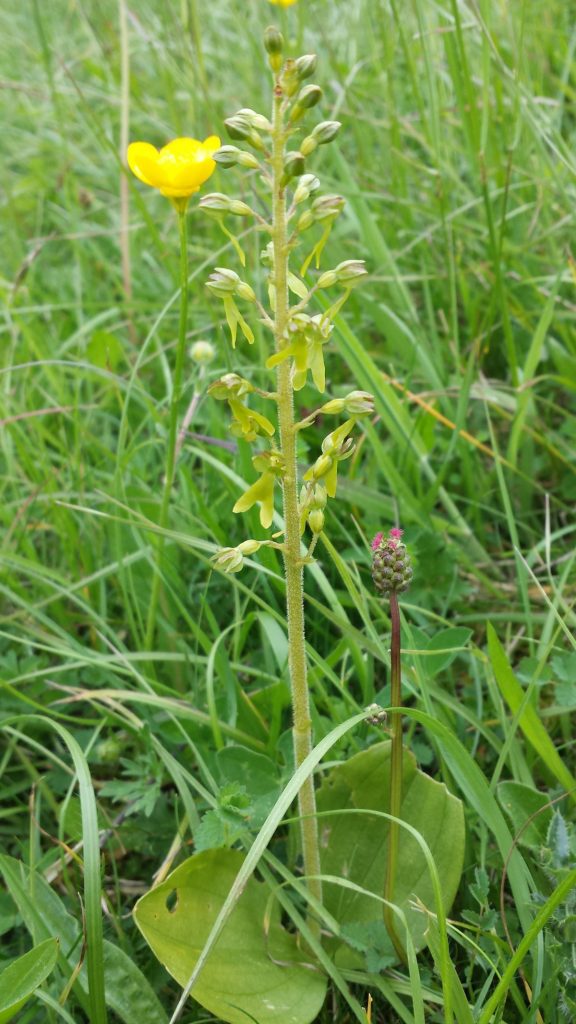
Common Twayblade near the Laurie lee trail sign
One of the special finds on this site is tucked away at the base of the hill below fly path, amongst the trees is a colony of around 120 White Helleborine. This elegant orchid comes into flower towards the end of May and its ivory coloured flowers with a yellow fleck when they slightly open makes them almost exotic. However it also makes them irresistible to the local deer, who munch most of them. It is the most predated orchid on the site. There is a second tiny colony close to a roadside fence by the Laurie Lee sign at the top end of Knapps lane. So far the deer haven’t found these!
Around the same time the Common Twayblade makes an appearance. This can be found across much of the site in a 50 metre band edging Knapps Lane, although it is easiest to see by the cattle grid at the top of the lane. Here the plants are larger than those found on the meadow proper.
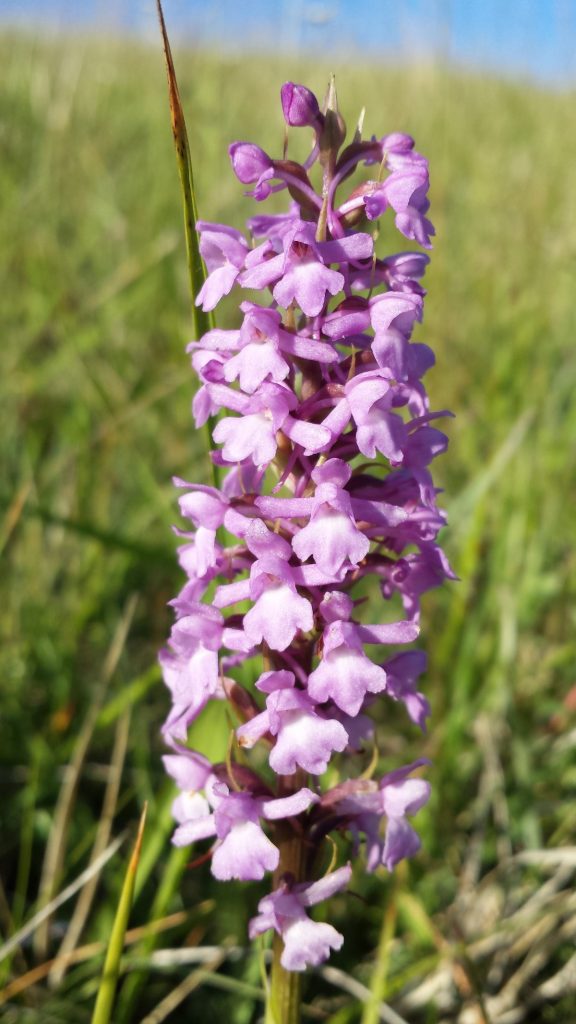
Chalk Fragrant Orchid between frog path and fly path
Moving up the hill and at the beginning of June the delicate and scented Chalk Fragrant Orchid can be found in swathe round from frog path to the above the site of the Fly Orchids, which by this time have usually finished flowering. Numbers vary by season but there are generally many dozens. They favour the hotter more sunbaked parts of the meadow and are, as a consequence, relatively small; especially when compared to the much larger colony on nearby Rodborough Common. Unlike on many sites the Chalk Fragrant Orchid here does not have much variety in form – no pink or white ones!
Interspersed with this species, but in far greater numbers are two of the most common orchids in the region and on this site too; the Common Spotted Orchid and, slightly later, the Pyramidal Orchid.
So far I have not found any hybrid forms of the Common Spotted Orchid although there are the related Frog Orchids there are no Marsh Orchids. Perhaps, like me they haven’t found the Frog Orchids yet!
One occasional sighting on Swift’s hill is the scarce white form of the Pyramidal orchid, although this seems to coincide with good seasons with plenty of regular forms.
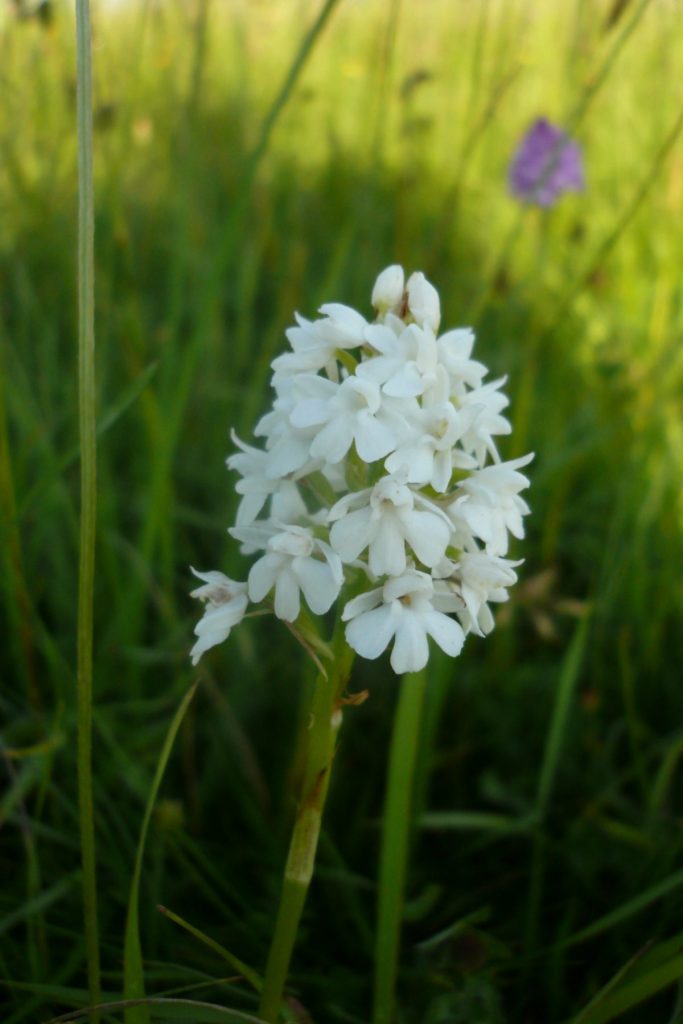
Pyramidal Orchid white form
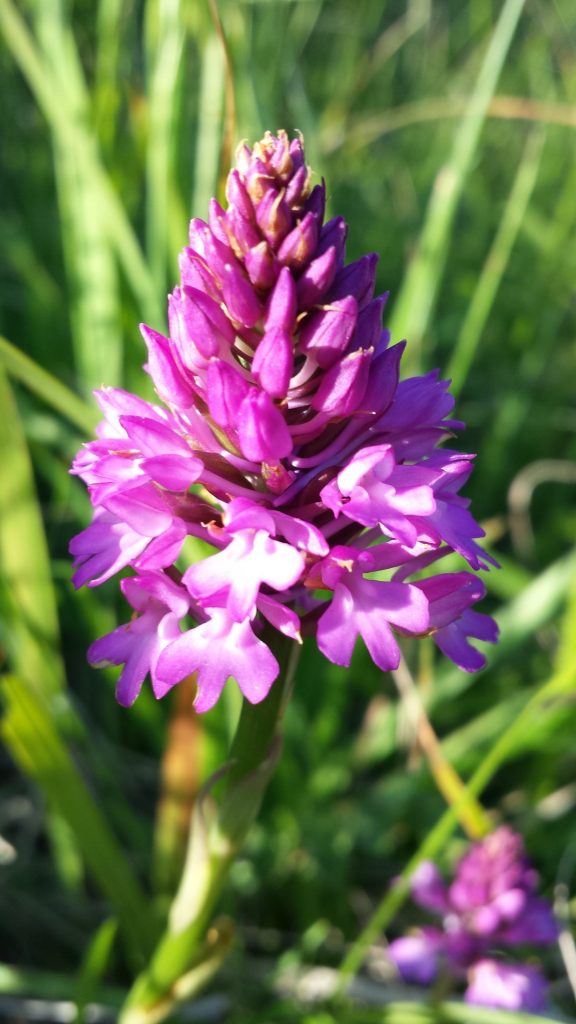
Pyramidal Orchid
Over the years I have only found the white form on the side of Swift’s Hill facing Slad, although the regular form is widely spread, rising to near the top towards the end further from the lane.
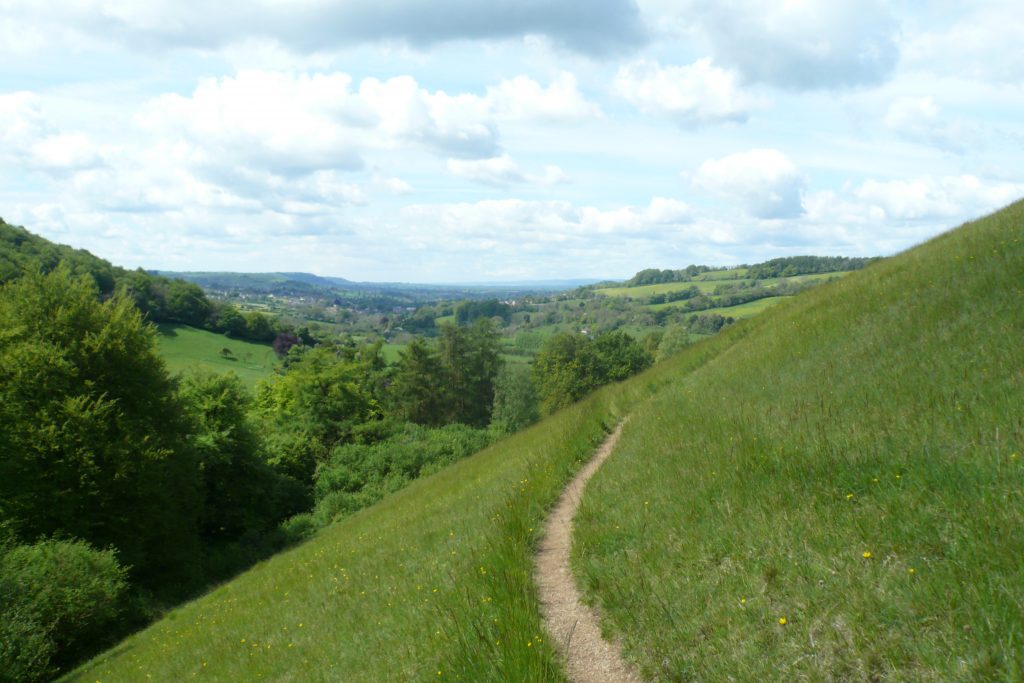
Fly path looking down Slad Valley to Stroud
The Common Spotted Orchid is widespread across Swift’s Hill. The forms are fairly typical although occasional white forms are found. In the lower reaches below fly path, the largest specimens are found up to 40cm tall, whereas around the fragrant orchid are they can be as small as 10cm with as few as 20 flowers per spike.
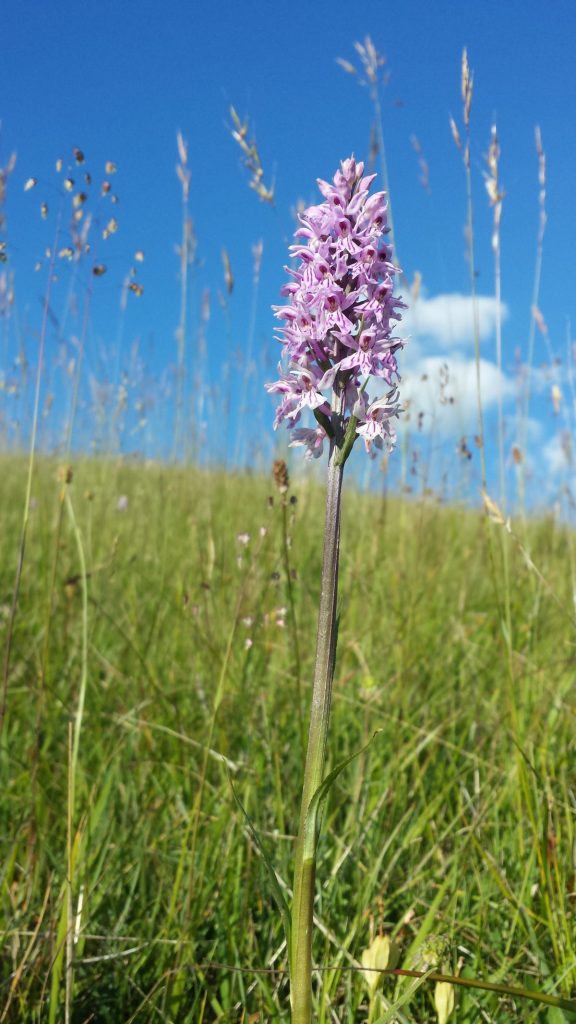
Common Spotted Orchid below fly path
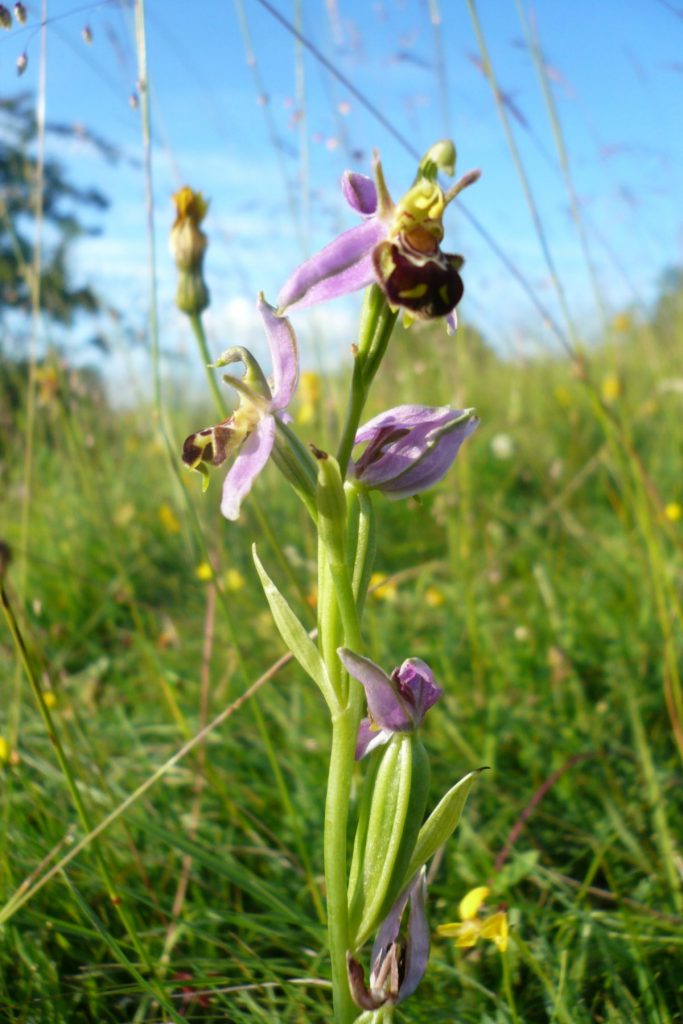
Bee Orchid towards the bottom of bee path
Although a common sight, searching out this species on a sunny June day shows the site in its best light with huge blue skies framed by tree lined hills and valleys towards views of the Forest of Dean on the horizon above Stroud.
Heading down the hill towards Knapps Lane using bee path and near the bottom, but before the slope steepens is one of the places to look for Bee Orchids, the other is near the Laurie Lee sign. Considering how common the Bee Orchid can be around the county it ain’t common here! Some years there aren’t any, but on a good season they can be 35cm tall with around 10 flowers. Best time for me has been in mid June. Interesting point about this site is that I have tended to find it around 1 week or so later than many sites in the area, although Cleeve Common is even later.
Again, unlike say Cleeve Common, only the regular form is found here.
The meadow is regularly grazed, as far as I am aware only by cattle and this doesn’t seem to harm the flowering population. Interestingly the best grass is at the top, where the hill levels slightly and the the grass is more lush. This tends to draw the cattle up to the top, although some flatter areas such as around the site of the Green Winged Orchids attracts grazing.
Following the Bee Orchids the site is pretty quite in terms of orchids, with only a few latecomer Common Spotted and Pyramidal Orchids providing any orchid interest, until mid July when a fairly large colony of Broad Leaved Helleborines begin to flower.
Taking what appears like a bridleway from Knapps Lane, just below the upper cattle grid and past the Laurie Lee sign you will see the beginning of the Broad Leaved Helleborine colony scattered amongst the Hazel.
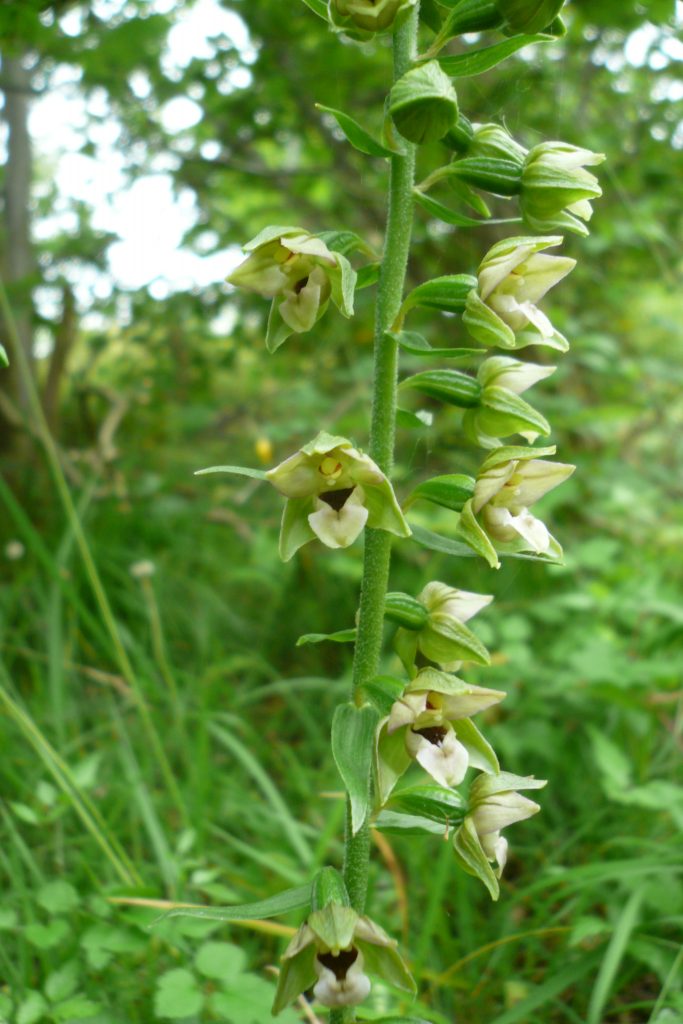
Broad Leaved Helleborine
For those of you familiar with the world of orchid hunting you will be relieved to know that the Broad Leaved Helleborines here are a pretty uncontroversial bunch. Flower colour, basal leaf form, lip size and shape all very regular! One of the unusual features is the largest part of the colony grows on loose scree of what appears to be a spoil heap with just a couple of Hazel bushes to provide limited cover. In spite of this the plants are fairly light and tall (up to 40cm), like woodland colonies. It also looks like the roots are very deep. For some reason there is very little predation, although in 2017 it was higher.
The flowering season lasts around three weeks, meaning that for around a fortnight in mid August the site is without orchid flowers. The only hope is for there to be an undiscovered Violet Helleborine colony in the woodland edge!
In the second half of August the last species flowers. The Autumn Lady’s Tresses is a small grey green species preferring the drier flatter parts of the hill. It can be found on the lower plateau, along bee path and along a fairly broad path that runs from a cluster of hawthorns towards fly path. I only came across the Autumn Lady’s Tresses colony in 2017 so only have information from this season.But the colony is quite large and widespread. Largest numbers appear to be at the bottom of bee path.
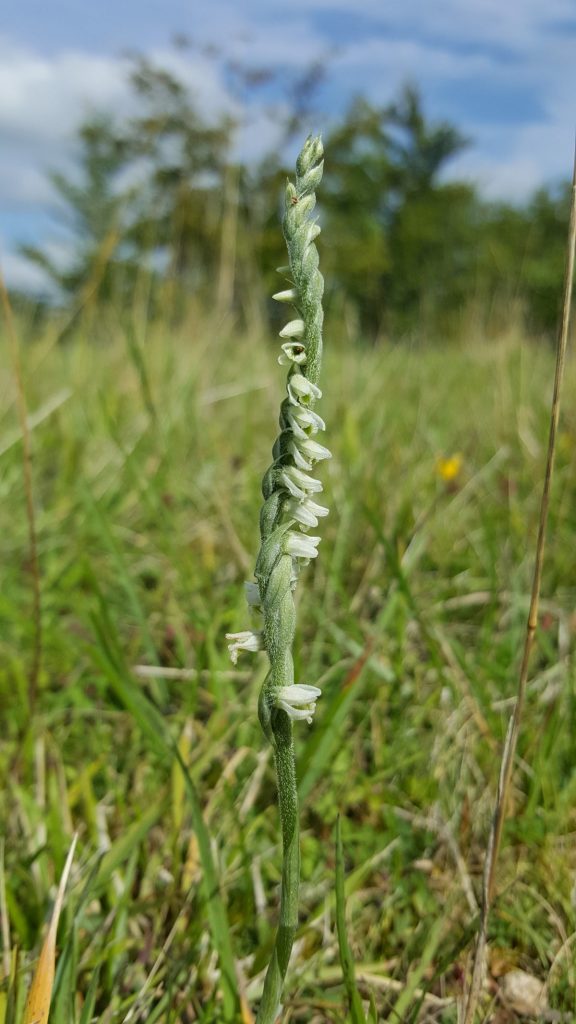
Autumn Lady’s Tresses on the plateau looking towards hazels / ‘bridleway’
I came to Swift’s Hill because of its orchids, but as is often the case what is good for one type of nature is good for others. The steepness of the hillside means that soil is thin and rather leeched. Consequently the vegetation is a paler yellowy green, which seems unhealthy. However this suits orchids as the grass is fairly short, few invasive species flourish and there seems to be little encroachment from scrub. Instead lots of more delicate grasses such as quaking grass grow. Also a number of unusual other plants can be found as can large numbers of butterflies.
Butterflies such as Small Blue, Grizzled Skipper and Marbled White are common. Many typical meadow flowers such as Century, Salad Burnet, Yellow Rattle and Stemless Carline Thistles are common, and there are several less common species.
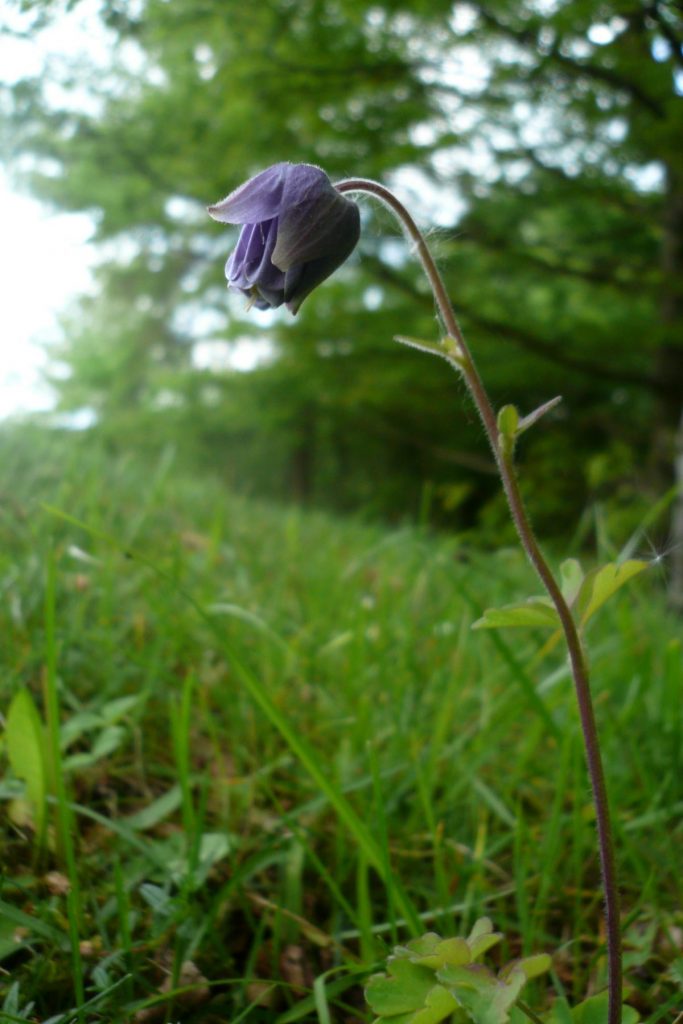
Columbine amongst the spoil heaps on the woodland edge
Around the spoil heaps of the main disused quarry Columbine can be seen, although this may be a reversion from a garden flower from garden refuse tipping several decades ago. Its rather small and almost aqua-marine flowers are generally single on branched stems. Up to 35cm tall.
In late Summer half way up the slopes facing the lower cattle grid there are fairly large numbers of Autumn Gentian. Due to the dry exposed conditions and the thin soil plants tend to be short – up to 20cm, though frequently shorter.
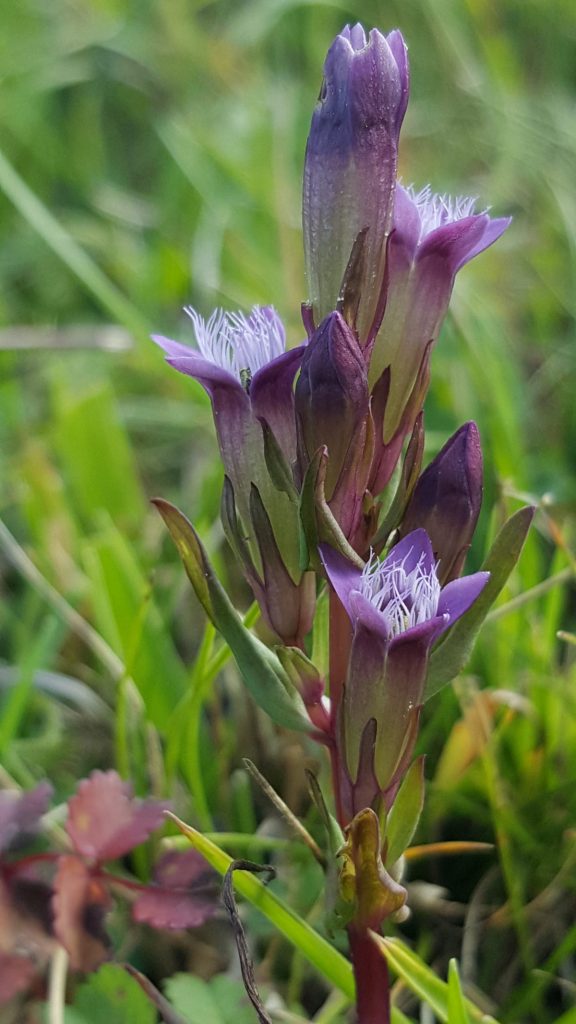
Autumn Gentian
Due to the large numbers of flowers on the meadow, its a great place to watch insects pollinating flowers
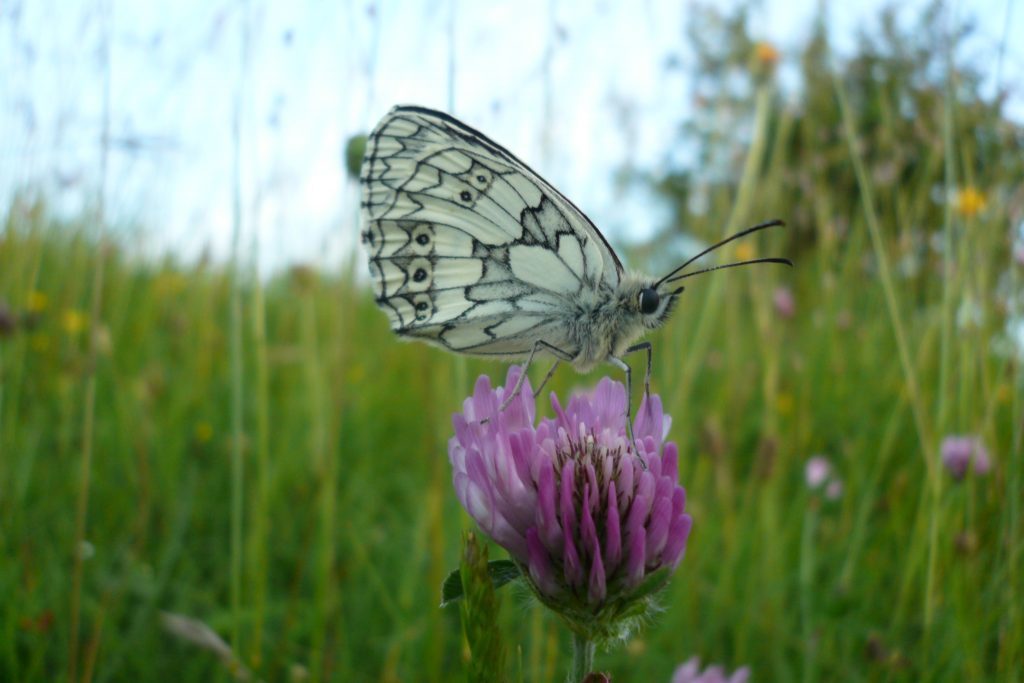
Marbled White taking a break on a red clover
Map Guide. The quarry is top centre, with the plateau between that and the lane moving downwards parallel to the lane is an area rich in varieties. The dotted line above the cross is frog path; 100 metres either side of that covers many species. The lowest dotted line is fly path. Beyond the silver birch tree is another area to search for Fly Orchids and White Helleborine. Finally the highest dotted line is the ‘bridle path’
2018 will hopefully see the completion of the orchid list for this site. And if you know of other species found on the site let me know!
